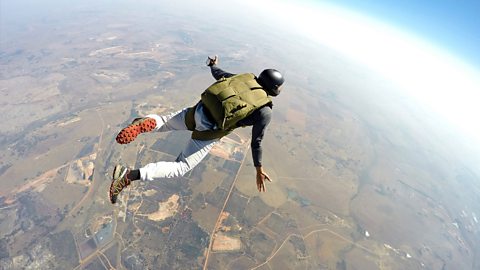Key points
A journey describes the motion of an object over time.
A journey can be represented using a distance-time graph.
The graph will show when an object is moving and when it is stationary.
The graph can also be used to calculate how fast the object is travelling.
Distance-time graphs
What is a distance-time graph?
A distance-time graphA graph with distance travelled plotted on the vertical axis against time taken on the horizontal axis. is a useful way to represent the motion of an object. It shows how the distance moved from a starting point changes over time.
Time in seconds is on the x-axis. Distance in metres is on the y-axis.
How to interpret a distance-time graph
Have a look at this graph.
At a, the object is travelling at a constant speed When the speed of an object remains the same - it does not increase or decrease., so it is shown with a straight diagonal line, where the gradientAnother word for steepness. On a graph, the gradient is defined as being the change in the 'y' value divided by the change in the 'x' value. The steeper the line, the larger the gradient. of the line tells you the speed.
At b, the object is accelerationThe rate of change of speed. This is calculated when the speed of an object changes. If an object is accelerating, this means that it is changing speed ÔÇô usually speeding up. so it is shown with a curved line which gets steeper.
At c, the object is travelling at a constant speed again, but this time it is faster, so the straight line is steeper - it has a larger gradient.
At d, the object is decelerationWhen an object is slowing down., so line is curved and gets less steep.
At e, the object is stationaryWhen an object is not moving. The object is sometimes described as being ÔÇśat restÔÇÖ., so its distance does not change as the time taken increases. This means that for a stationary object, the line is flat and the gradient (the speed) is zero.
Calculating speed from a distance-time graph
The gradient of the line on a distance-time graph is equal to the speed.
Calculate the gradient of the line using the following equation:
\(gradient = \frac {change~in~y~value}{change~in~x~value} \)

When the speed is calculated from a distance-time graph, the units for speed will depend on the units used for the y axis (distance) and the units used for the x axis (time taken).
For example, if the distance is in m (metres), and the time is in s (seconds), then the calculation involves:
m ├Ě s
and the units will be m/s.
If the distance is in km (kilometres), and the time is in h (hours), then the calculation involves:
km ├Ě h
and the units will be km/h.
In the units for speed, the / symbol means the same as the ├Ě symbol.
Calculate the speed of the object represented by the green line in the graph, from 0 to 4 s.
change in distance = (8 - 0) = 8 m
change in time = (4 - 0) = 4 s
\( speed = \frac {distance}{time} \)
\(speed = 8 ├Ě 4\)
\(Speed = 2 m / s\)
Calculating average speed from a distance-time graph
Watch Brian Cox explain how to calculate average speed using a distance-time graph.
Let's now think of a slightly different concept, the concept of average speed.
So let's say that you decide that on your way from home to school, you decide to stop at a shop, and that shop is halfway between home and school. So it's five hundred metres from your house, and another five hundred metres to school.
So what will that journey look like?
Remember, we said that you're going to do a brisk walk or a light jog, travelling at about one hundred metres per minute, but now we're going to stop at the shop for ten minutes.
Well, you can represent a journey like that on one of these graphs which is called a distance-time graph. So I've drawn the distance on this vertical axis here - distance in metres - and that's a zero all the way up to a thousand metres, home to school. And the time on the horizontal axis and I've labelled this in minutes. I started at zero and I've gone all the way up to twenty minutes.
So this first bit of the journey is the bit of the journey when you're travelling at a hundred metres per minute, jogging along from home to the shop.
So you travel - remember what speed means - you travel one hundred metres in one minute, and two hundred metres in two minutes, and three hundred metres in three minutes, all the way to five hundred metres in five minutes, where the shop is.
You then wait. You stay in the shop for ten minutes, so you don't move. You don't go anywhere. You stay in the same place, but time ticks along. You waste or spend ten minutes in the shop.
Now after ten minutes, you leave the shop and you set off again, travelling at a hundred metres per minute. And what that means, it means that after one more minute, you've gone another hundred metres; in two minutes, two hundred metres; and so on, all the way to the final five hundred metres to school, which takes you five minutes.
So the whole journey, including a stop at the shop, has taken you twenty minutes. And during the whole journey, you have travelled one thousand metres.
So what's your average speed for the journey?
Well, that's the total distance you've travelled, divided by the total time it took. One thousand metres, divided by twenty minutes, that is fifty metres per minute.
Test yourself
The distance-time graph below represents a car's journey. Have a look at the graph and answer the following questions:
At which part of the journey was the car stationary?
At what point in the journey was the car travelling the fastest?
What is the total distance travelled by the car?
How far did the car travel between 2 seconds and 3 seconds?
Calculate the speed of the car between 2 seconds and 3 seconds.
C
B
6 metres
At 2 seconds the car had travelled 1 m and by 3 seconds it had travelled 4 m.
4 - 1 = 3.
The car travelled 3 m between 2 seconds and 3 seconds.
- The car travelled 3 m between 2 seconds and 3 seconds.
3 ├Ě 1 = 3
The speed of the car between 2 seconds and 3 seconds was 3 m/s.
Test your knowledge
Quiz - Multiple choice
Play the Atomic Labs game! gamePlay the Atomic Labs game!
Try out practical experiments in this KS3 science game.

More on Forces and movement
Find out more by working through a topic
- count6 of 16

- count7 of 16

- count8 of 16

- count9 of 16
